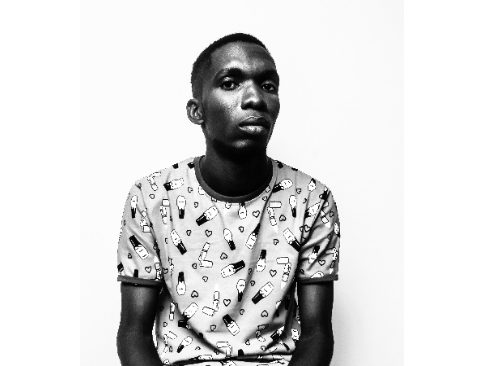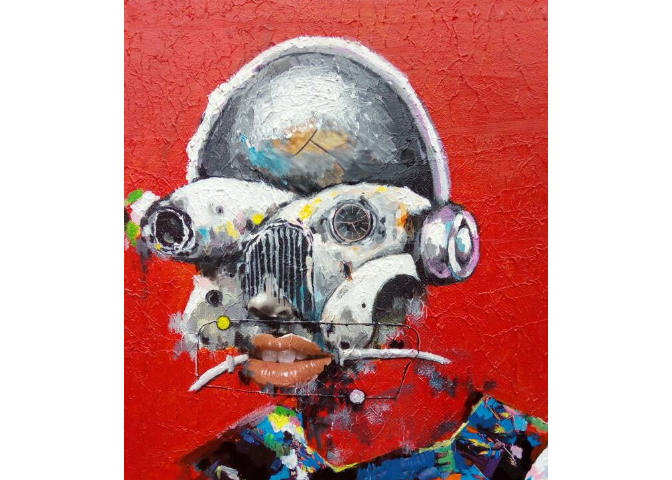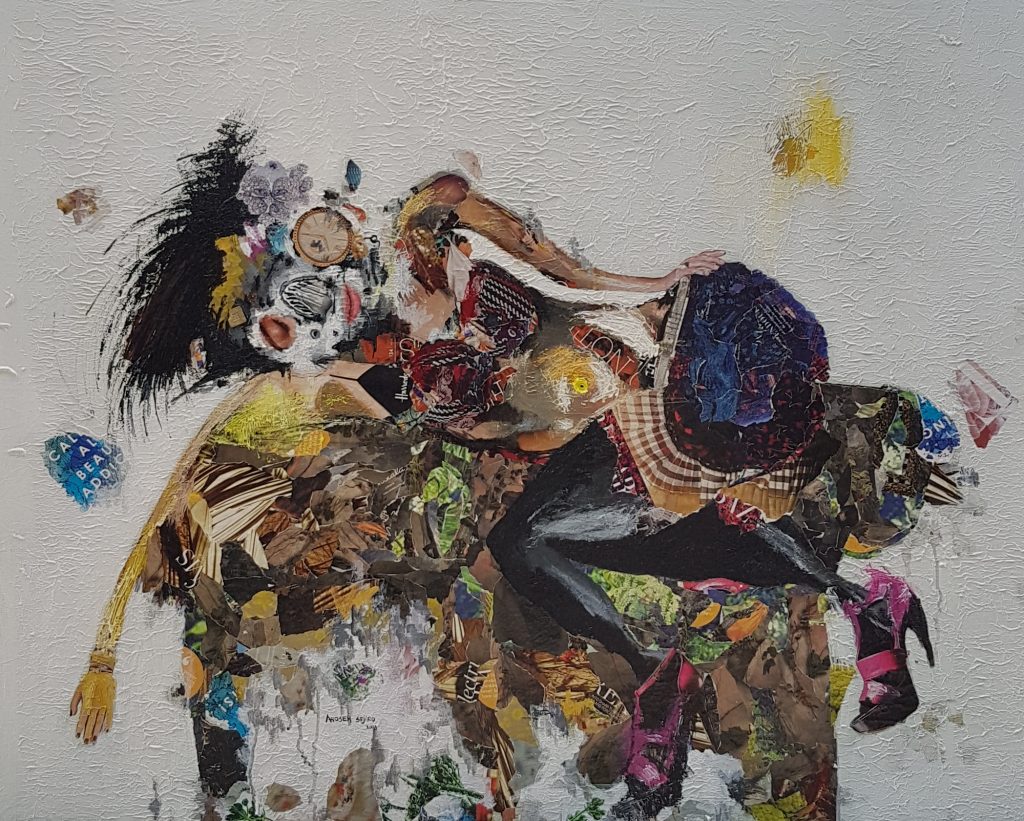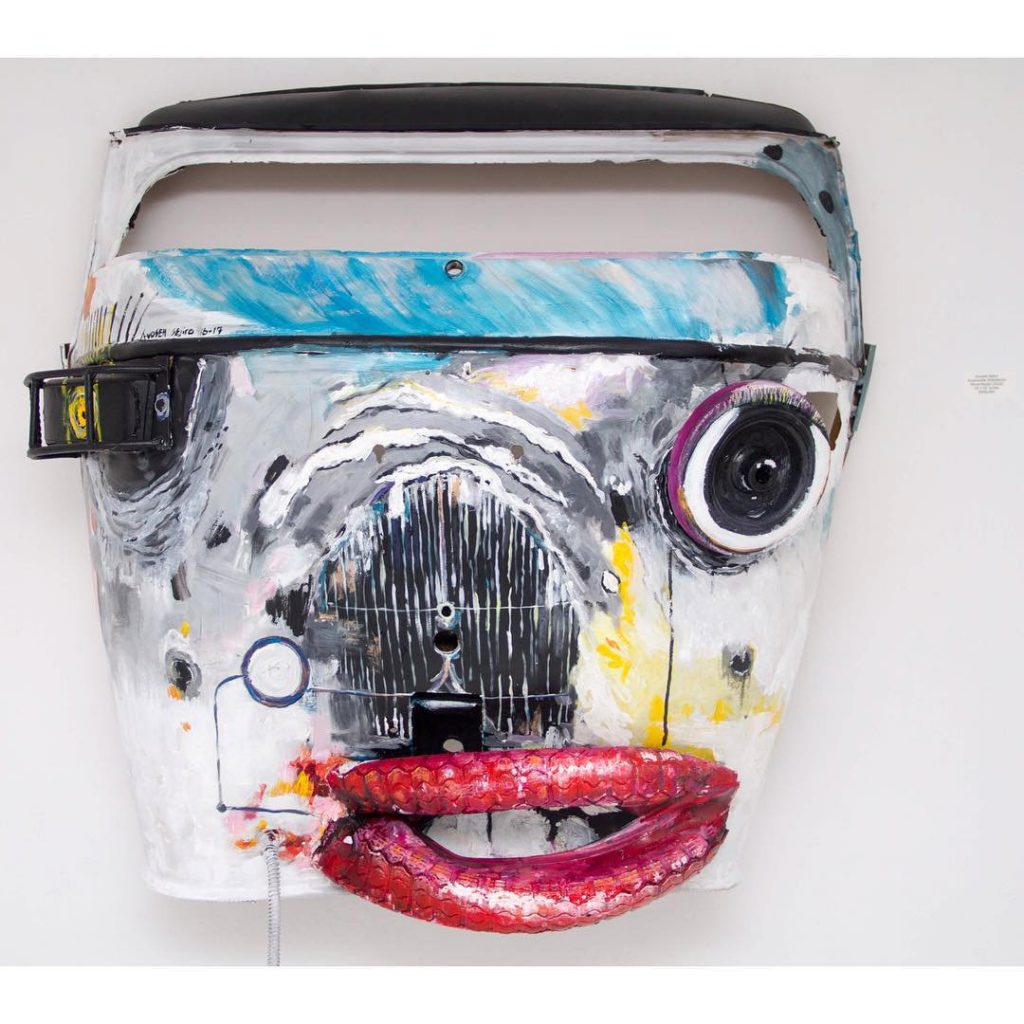From Rele 2017 Young Contemporaries exhibition to performing at West Africa’s 1st International Art Fair, Art X Lagos, and being published in CICA Museum’s Art Yellow Book in South Korea, Sejiro Avesoh, a young artist living in Lagos, is steadily becoming a name to notice. At the beginning of this year, Jess Castellote, Independent Art Advisor and Author, listed his name as one of the “18 Nigerian young visual artists under 30” he will follow their work in 2018.
Born in 1991, Avoseh, a graduate of Art and Industrial Design from Lagos State Polytechnic has practiced as a full-time artist for only two years. Prior to this, he worked in broadcast media for five years at Television Continental (TVC), Bloomberg TV (in Nigeria) and Wazobia TV. Using components of automobiles, he presents subjects of daily life and his experiences in surreal figurative paintings. Prominent features in his paintings are disintegrated automobile human faces and timepieces.
In the conversation with him at Rele gallery, we talked about his experiences, the automobile elements in his paintings and the possibility of seeing more of his work in 3D.

First, I want to ask, the images that you create, what are they about? There are car headlights and tyres, timepieces and so on presented in human forms.
Yes, basically, my art personifies automobiles. I see myself as a traveller in life and most of what I paint are things and events around me. Why I use automobile-like faces or forms is because I see life as a journey. I personify the cars as breathing entities.
When you say you personify cars as breathing entities, does this come from a place of fascination with automobiles or you stumbled on using auto parts as a metaphor?
Some automobiles have features that make them look… Some look feminine and some look masculine. For example, looking at the Beetle car, naturally, it has the facial feature of a female and when you look at some cars for example like some lorries, they look masculine. I stumbled on these attributes when I was planning to buy a car. I had the plan to buy a particular car but a friend told me the car looks feminine, and so, more suitable for a woman. It made me wonder if the people designing these automobiles actually design them to look feminine or masculine.
Don’t you think this projection comes from how we have assigned certain things to women and to men? Did you research to know if this is deliberate on the manufacturers’ end?
In my research, I saw that cars are meant to be used generally but we the users, maybe due to their physical features, tagged certain cars to a gender.
What were you painting before now?
I was painting landscapes, mostly Lagos street scenes. I have done some experiments with Ghana must go. I have used lines. I have done lots of experimental works but I think they were not successful.
What made you think they were not successful?
They were not really talking to me like how these new works do. I was not comfortable and the confidence was not there to take them out. When you create a good piece, as an artist, I think you will not only be happy with it, you will feel connected and comfortable with it. When I had that conversation about the characters attributed to cars with my friend, I went into the studio and did some experimenting. At first, I was just placing cars on canvas. I will paint to get a particular brand like for example a Beetle car. I would paint a female figure and place the car on it. I met a number of critics then who didn’t think that was cool. After a lot of practice and attempts, I told myself instead of depending on brands, pictures, and automobile images to create these works, why not imagine these automobile faces and features, and create your own thing. This was how I arrived at the ones you see now.

Do you sometimes mix elements of different cars, like play mix and match?
What I do is that I use car elements. The tyre, for instance, I use for the eyes and as a statement that we are responsible for whatever happens in life. There are other parts that I use, like the front grill of a car, or the rim. It depends on how it comes to my mind. It is not as if I have a particular feature that I use every time.
Are you first making a statement when you work or you are having fun and playing around with images?
It depends on the piece. There are some works where I just want to express myself and enjoy the work. In some other works, I am making a statement. There are other times when I feel like I just want to make a good work of art and I balance both.
Could you give instances with some works?
There is a piece I call Bolatito with her pet. It was inspired by my lover and her pet. She is my wife now, we got married last year. She was playing with her little dog and I painted it out of affection for them. There is also Stay with me. I was painting my emotion on how one feels incomplete when certain people you want in your life are not there. It is a longing for completeness in a different form. As humans, we need other people to complement our efforts for a meaningful life and success. In the painting, two human forms came together but you cannot figure that out because it looks like one human form. If you look closely, you will find four hands.
Let’s talk about you as an artist, your childhood, your academic background. Did you always know there was art in the near future?
I cannot actually remember wanting to become an artist as a child. I can only recollect that when I was in secondary school, like two years to finishing my secondary education, people told me I am very good at drawing, mostly because of my biology diagrams. Though unrelated to why studied art, I ended up studying Art and Industrial Design at the Polytechnic. Even then, I never saw myself as an artist.
What did you see yourself as?
I saw myself as an engineer. I was good in scattering things and bringing them back together. Once, I pulled apart the radio, destroyed it and made it work again.
Do you see yourself in this way as a painter? It seems as if you are doing something similar in your paintings – scattering and putting things together? Do you see that?
It is funny that you see that. At times, I just do some things unconsciously. People, who see these things then tell me “Can’t you see this?” There are some things that I do in my work that I don’t know or don’t see them.
You mentioned before that you see life as a journey and you see the automobiles as a representation of that journey. Could you explain what you mean by this and if this comes from a personal place?
I see life as a journey and I use automobiles metaphorically as a representation of my travelling through life. Life has not been easy for me right from my childhood. If you look at my work, you will observe that I mostly use feminine figures. This is because I grew up with my mum and sister. My life was centred around a mother and a sister, and it was not easy. Sometimes, things are good, sometimes they are down, really down.
Do you bring this into your work or do you use your work to escape from these experiences?
No, I don’t, but I work as an artist to find happiness. Whenever I am sad, I put that on the canvass. At other times, it is what I create that gives me joy. Making money out of art is secondary for me. The main reason I create art is to find happiness, to feel fulfilled and express myself. I think this is the only way I can express myself.

Does this explain the black background of Stay with me? There is a mood to it.
Yes! But, I have some lighter ones. There is also the series Faces in Black. It comes from a time when I was down. Things were as bad as I want to create art but don’t have materials to use.
Is this connected to a piece with a woman holding cigarette? It seems a part of the series Faces in Black. But, in this particular work, I see a woman who appears to be happy or having fun.
I don’t know if she is happy but her disposition seems as if she is happy or having a good time and the man in the piece looks like he is having a good time too.
Your women, they happen to be sexy. Are they women on the run?
SA: Maybe. I will explain with The Nap. The female subject in it is someone I know. Due to the high rate of unemployment in the country, she is not working regular jobs. She is supposed to be working during the day and then maybe sleep at night but it is otherwise. She sleeps during the day and you see her go out at night. This painting was made of her during the day. She still had her makeup and shoes on from the night’s work. When she returns from her ‘work’ in the morning, she is tired and just wants to sleep. At the time, she could not afford to buy herself a bed, so she sleeps on a couch. A furniture that can barely accommodate her. These are the sexy women you see. There are not many of them I have painted.
Did she sit for this painting or this is your projection?
I try to create my own story out of these true stories so the persons don’t feel offended.
Now that you are an artist, has it been worth your while? Do you feel you are a part of this system?
Yes. The truth is when I work, I take it off my mind whether it is going to sell or not. The main thing I do is to enjoy it. Having a gallery like Rele has been encouraging too. Navigating the art scene was quite challenging before joining the gallery. I was literally begging people to see what I do. But when I came here, things changed. I became more encouraged to work.
Did this influence the scale of your work? If I recall well, your paintings in 2016 were mini sizes.
Then, I can remember, the works were not matured compared to what you see now. I was just placing cars on the human body. In terms of size, I owe that to the influence and support of the gallery that enables me to explore more. I feel comfortable to face bigger surfaces and explore more themes.
Are there other surfaces, aside from the canvas, you would like to work on? For instance, your work has the potential for 3D and sculptural installations.
I made an installation already. It was exhibited at the young contemporaries show in 2017. I cut out the face of a tricycle and transformed it into art in the manner of my paintings. I have also worked on glass. I did a commission piece on a glass, a four and a half by five feet glass. Going into 3D, it depends on my mood. I prefer to use a material or medium when I have something to say in it. If I do not have anything to say in 3D, then it is better I don’t do 3D works. But, fingers crossed until July. (laughs). Let’s see how it goes.
Do you have an exhibition coming up then and are you likely to go in this direction?
Yeah! Let’s wait and see.

Bukola Oyebode is a contributor and editor at TSA.




